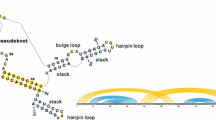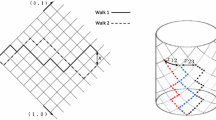Abstract
The Penner interaction known in studies of moduli space of punctured Riemann surfaces is introduced and studied in the context of random matrix model of homo RNA. An analytic derivation of the generating function is given and the corresponding partition function is derived numerically. An additional dependence of the structure combinatorics factor on N (related to the size of the matrix and the interaction strength) is obtained. This factor has a strong effect on the structure combinatorics in the low N regime. Databases are scanned for real ribonucleic acid (RNA) structures and pairing information for these RNA structures is computationally extracted. Then the genus is calculated for every structure and plotted as a function of length. The genus distribution function is compared with the prediction from the nonlinear (NL) model. The specific heat and distribution of structure with temperature calculated from the NL model shows that the NL interaction is biased towards planar structures. The second derivative of specific heat changes phase from a double peaked function for small N to a single peak for large N. Detailed analysis reveals the presence of the double peak only for genus 0 structures, the higher genii behave normally with N. Comparable behaviour is found in studies involving interactions of RNA with osmolytes and monovalent cations in unfolding experiments.






Similar content being viewed by others
References
H S Camarda and P D Georgopulos, Phys. Rev. Lett. 50, 492 (1983)
V V Sokolov and V G Zelevinsky, Nucl. Phys. A 504, 562 (1989) Y V Fyodorov and H-J Sommers, J. Math. Phys. (N.Y.) 38, 1918 (1997)
R C Penner, Bull. Am. Math. Soc. 15, 73 (1986); ibid., J. Diff. Geom. 27, 35 (1988) V A Kazakov, Mod. Phys. Lett. A 4, 2125 (1989) J Distler and C Vafa, Mod. Phys. Lett. A 6, 259 (1991) C-I Tan, Phys. Rev. D 45, 2862 (1992)
R Balian, Nuovo Cimento B 57, 183 (1968)
K Efetov, Supersymmetry in disorder and chaos (Cambridge University Press, Cambridge, 1997) T Guhr, A Muller and H A Weidenmuller, Phys. Rep. 299, 189 (1998) P J Forrester, N C Snaith and J J M Verbaarschot, J. Phys. A: Math. Gen. 36, R1 (2003)
A M Tulino and S Verdu, Random matrix theory and wireless communications (Now Publishers Inc, Hanover, 2004)
L Laloux, P Cizeau, J P Bouchaud and M Potters, Phys. Rev. Lett. 83, 1467 (1999) X Gobaix, P Gopikrishnan, V Plerou and H E Stanley, Nature (London) 423, 267 (2003)
P A Lohse and J W Szostak, Nature 381, 442 (1996) P J Unrau and D P Bartel, Nature 395, 260 (1998)
Geoffrey Werstuck and Michael R Green, Science 282, 296 (1998)
S D Hatfield, H R Shcherbata, K A Fischer, K Nakahara, R W Carthew and H Ruohola Baker, Nature 435, 974 (2005)
M S Waterman, Stud. Appl. Math. 60, 91 (1979) C Haslinger and P F Stadler, Bull. Math. Biol. 61, 437 (1999) T Akutsu, Disc. Appl. Math. 104, 45 (2000) E Y Jin and C M Reidys, Bull. Math. Biol. 70, 45 (2008)
G Vernizzi, H Orland and A Zee, Phys. Rev. Lett. 94, 168103 (2005) Hemi Orland and A Zee, Nucl. Phys. B 620, 456 (2002)
G ’t Hooft, Nucl. Phys. B 722, 461 (1974)
I Garg and N Deo, Pramana – J. Phys. 73, 533 (2009)
I Garg and N Deo, Phys. Rev. E 79, 061903 (2009)
I Garg and N Deo, Eur. Phys. J. E 33, 359 (2010)
P Bhadola, I Garg and N Deo, Nucl. Phys. B 870, 384 (2013)
P Bhadola and N Deo, Phys. Rev. E 88, 032706 (2013)
F Colomo and A G Pronko, J. Stat. Phys. 138, 662 (2010) V E Kravtsov, Handbook on random matrix theory (Oxford University Press, New York, 2010) E Bogomolny and O Giraud, Phys. Rev. Lett. 106, 044101 (2011)
L Chekhov and Yu Makeenko, Mod. Phys. Lett. A 14, 1223 (1992) N Deo, J. Phys. A: Math. Gen. 36, 3617 (2003) N Deo, Phys. Rev. E 68, 026130 (2003) R J Szabo and M Tierz, J. Phys. A: Math. Theor. 43, 265401 (2010)
L F Cugliandolo, J Kurchan, G Parisi and F Ritort, Phys. Rev. Lett. 74, 1012 (1995) L F Cugliandolo, J Kurchan and G Parisi, ROM2F/94/27
N Deo, J. Phys. A: Math. Gen. 36, 3617 (2003) N Deo, Phys. Rev. E 68, 026130 (2003)
C-I Tan, Phys. Rev. D 45, 2862 (1992) R C Brower, N Deo, S Jain and C I Tan, Nucl. Phys. B 405, 166 (1993) N Deo, Nucl. Phys. B 504 [FS], 609 (1997)
H Yang, F Jossinet, N Leontis, L Chen, J Westbrook, H M Berman and E Westhof, Nucl. Acids Res. 31 (13), 3450 (2003)
A Pagnani, G Parisi and F Ricci-Tersenghi, Phys. Rev. Lett. 84, 2026 (2000)
Dominic Lambert and David E Draper, J. Mol. Biol. 370, 993 (2007)
P L Privalov and V V Filimonov, J. Mol. Biol. 122, 447 (1978)
Acknowledgements
PB thanks UGC for research fellowships and ND thanks CSIR Project No. 03(1197)/11/EMR-II and the University Faculty R&D research programme for financial support.
Author information
Authors and Affiliations
Corresponding author
Rights and permissions
About this article
Cite this article
BHADOLA, P., DEO, N. Matrix models with Penner interaction inspired by interacting ribonucleic acid. Pramana - J Phys 84, 295–308 (2015). https://doi.org/10.1007/s12043-014-0920-5
Published:
Issue Date:
DOI: https://doi.org/10.1007/s12043-014-0920-5




